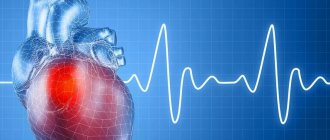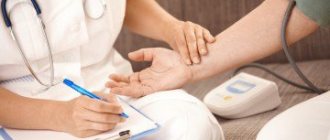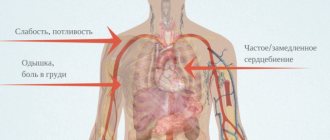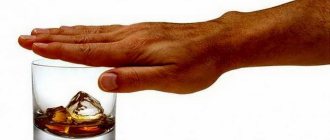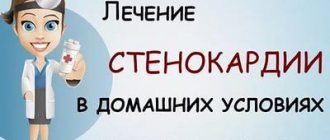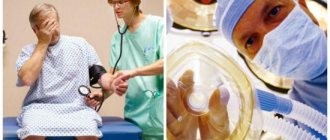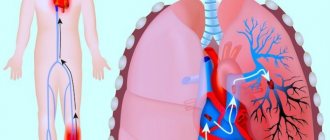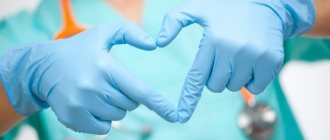Causes of arrhythmia at night
The main factor in predominantly nocturnal cardiac arrhythmias is an imbalance between sympathetic and parasympathetic regulation of myocardial contractions. The night is called the “kingdom of the vagus,” that is, the vagus nerve, which belongs to the parasympathetic department. It is thanks to this that blood pressure decreases and the pulse slows down during this period.
If vagal activity decreases, this increases the sympathetic influence on the conduction system. Under the influence of stress hormones, the pulse and respiratory rate accelerate, cardiac output and blood pressure increase. Tachycardia, extrasystole and attacks of flickering or fibrillation occur, as a rule, against the background of sympathicotonia.
With increased tone of the parasympathetic system, patients are diagnosed with bradycardia and inhibition of the passage of impulses through the myocardium in the form of blockade of the atrioventricular node.
Diseases in which nocturnal forms of arrhythmia occur:
- neurosis, panic attack, depression;
- cardiopsychoneurosis;
- arterial hypertension with nocturnal increases in pressure;
- sleep apnea syndrome (stopping breathing during snoring);
- cardiac ischemia;
- diabetes;
- cardiomyopathy;
- disturbance of potassium and magnesium levels in the blood;
- thyroid diseases;
- nicotine and alcohol addiction;
- anemia;
- infections;
- intoxication, including drugs.
The most common cause of nocturnal arrhythmias is sleep apnea syndrome. It occurs when muscles are weak or the volume of the soft palate increases. This pathology is diagnosed mainly in men who are overweight, take sleeping pills or abuse alcohol.
Each episode of respiratory arrest signals the brain about danger, and stress hormones are released. This leads to an acceleration of the heart rate, and during apnea it slows down sharply. Such fluctuations in heart rate cause various forms of arrhythmia, angina attacks, and changes in blood pressure levels, which impair blood supply to the myocardium and brain.
We recommend reading the article about an attack of atrial fibrillation. From it you will learn about the symptoms of attacks, ways to restore sinus rhythm, and assistance at home.
And here is more information about the causes and symptoms of atrial fibrillation.
Arrhythmia in the supine position
Different people have their own individual pulse, which is absolutely normal for them. For some it is higher, for others, on the contrary, lower, usually the figure fluctuates in the range of 60–80 beats per minute. When a person feels disturbances in the functioning of the heart, it is likely that arrhythmia will develop.
Healthy people, being at rest, do not feel how their heart works, feeling only small beats. For patients with atrial fibrillation, any disruption to the normal functioning of the “motor” becomes noticeable.
Problems with heart rhythm are associated with a violation of the formation and transmission of electrical impulses, due to which myocardial systole occurs
In medicine, a certain classification of arrhythmias has been adopted, each of which develops as a result of a combination of certain factors characteristic of this particular type of disease. But it is possible to identify some similarity in the causes that provoke all types of the disease:
- Organic factors include coronary heart disease, various defects, carditis and other diseases.
- Functional factors include both reflex and psychogenic causes.
- Failure in the normal functioning of the thyroid gland provokes hormonal imbalance, which can also lead to arrhythmia.
- Abuse of alcoholic beverages and cigarettes prevents the heart from working steadily.
- The disease can also be caused by the use of certain medications.
- Hereditary predisposition often triggers the development of the disease.
- Mechanical factors include injuries sustained during surgery.
Heart rhythm disturbances do not always pose a threat to human life due to the fact that the primary source of such a physiological reaction may be increased physical activity or sex. But there are also some diseases that provoke arrhythmic attacks during sleep.
Knock in the heart at night
Some patients note that during the day they do not feel the work of the heart, but at night they hear its beat, which can be a sign of:
- physical fatigue;
- emotional overstrain;
- effects of caffeine, nicotine, alcohol;
- eating a large meal at dinner or right before bed;
- excitement, anxious thoughts.
The condition is not dangerous unless there is heart pain, difficulty breathing, dizziness or fainting. In such cases, it is usually enough to reduce daytime loads, change your diet, and give up bad habits, especially in the evenings.
You should definitely consult a doctor if you have the following symptoms:
- the attack lasts more than 5-7 minutes, does not go away in a state of complete rest;
- there are interruptions, failures in heart contractions, “turning over” in the chest;
- nausea and flushing of the face occurs;
- darkens in the eyes.
Night heartbeats in women
The causes of nighttime palpitations in women are often hormonal changes. This happens during menopause, pregnancy, and the use of contraceptives with hormones. Such attacks also occur as a reaction to medications, including those for high blood pressure, diuretics, and laxatives.
To normalize the rhythm, use:
- potassium and magnesium preparations - Panangin, Magne B6;
- improving metabolic processes in the myocardium - Mildronate, Kratal;
- calming – Persen, Fitosed.
Treatment in each specific case should be prescribed by a cardiologist after examination; self-medication is especially dangerous during pregnancy.
Symptoms of seizures during sleep
Changes in heart rate cause patients to feel palpitations, anxiety or sudden panic, discomfort or pain in the heart area, and difficulty breathing. Sudden awakenings and nightmares may be signs of heart rhythm problems. When extrasystole occurs, there may be tremors in the chest or “turning over” of the heart.
In the morning, patients experience typical manifestations of poor sleep quality:
- severe weakness, weakness;
- dizziness when getting out of bed;
- irritability;
- memory impairment;
- difficulty doing work that requires concentration.
These signs may be accompanied by pale skin, coldness of the extremities, blurred vision in the form of flashing dots before the eyes, and fainting due to ineffective cardiac output with serious heart rhythm disturbances.
Symptoms of the disease
Arrhythmia manifests itself individually in each specific case. Usually people, being in a lying position, do not feel any cardiac discomfort, but as soon as they find themselves on their left side, a palpable palpitation immediately begins to appear.
Nocturnal arrhythmia, which can lead to extremely negative health consequences, requires special attention.
To get rid of unpleasant discomfort, an ordinary healthy person just needs to lie on his back and everything goes away on its own. Those who have the pathology can expect multiple repetitions of symptoms as soon as they find themselves in a supine position. In view of this, when the disease manifests itself, you need to pay attention to some signs characteristic of one of the types of arrhythmia:
- When the heart rate is about 90 beats per minute, sinus tachycardia can be detected. It may also be accompanied by shortness of breath, increased fatigue, and general weakness. Atrial fibrillation often appears as a complication. If it manifests itself against the background of increased physical activity, then holding your breath will relieve the symptoms.
- The downside is a decrease in heart rate to 55 beats per minute and even lower, which is inherent in sinus bradycardia. The disease is accompanied by hypotension, fainting, weakness, dizziness, and aching pain in the chest.
- With untimely contraction of the cardiac chambers or the heart, in general, the phenomenon of extrasystole is observed. The frequency of impulses usually occurs after 1-3 normal contractions. Some patients may experience no symptoms at all, while others will experience a complete cessation of cardiac activity. With a rare manifestation, such a disease does not pose a danger.
- When a patient's heart rate increases during exhalation and decreases during inhalation, we can talk about the presence of sinus (respiratory) arrhythmia. Often, breathing difficulties are associated with experiencing strong emotions or heavy physical labor.
Read also: Atrial fibrillation treatment in Minsk
The heart consists of two fragments - left and right, between which there is a septum
- With incomplete contraction of the atria and frequent contraction of the ventricles, atrial fibrillation is diagnosed. The disease does not allow normal blood circulation, which negatively affects the entire body.
If any of the symptoms occur, you must immediately contact a medical facility. The manifestations of the disease cannot be ignored due to the fact that possible complications that arise as the disease progresses can lead to catastrophic consequences for the body, including death.
Why nocturnal arrhythmia is combined with insomnia
Heart rhythm disturbances lead to the fact that the parts of the heart lose the ability to coordinate contractions, an insufficient amount of blood enters the ventricles, and its release into the arterial network decreases. When conduction slows down in the case of atrioventricular block or bradycardia, the cardiac output decreases.
Low blood flow, especially when combined with respiratory arrest, is recognized by the brain as a danger signal, which causes awakening from sleep. Shallow and intermittent sleep disrupts the functioning of the nervous and cardiac systems, leading to a vicious circle. Nocturnal arrhythmia and apnea are risk factors for sudden cardiac arrest.
Insomnia and rhythm disturbances can also be caused by taking tonic drinks, alcohol, coffee in the evening, stressful situations, overwork, hormonal imbalance, frequent night shifts, moving to an area with a different time zone.
Is the condition so dangerous?
Nocturnal arrhythmia can transform into ventricular fibrillation and circulatory arrest, which is equivalent to the onset of clinical death. In patients with myocardial damage or heart defects, severe angina, pulmonary edema may develop during an attack.
When the conduction of cardiac impulses is completely blocked, the ejection of blood from the ventricles and blood pressure drop sharply; this is dangerous by stopping the nutrition of the brain and heart with irreversible consequences.
Atrial fibrillation, the risk of which increases with sleep apnea syndrome, often causes blood clots to form in the heart and travel through the arterial network. Thromboembolism of the brain results in a stroke, and blockage of the coronary arteries of the heart causes a heart attack.
What explains the attack?
In people with cardiac pathologies, heart beats are clearly felt while resting on the left side. This happens due to increased stress on the heart. When you lie on the side of the heart, the myocardium is pinched, increasing the load and adverse symptoms. Therefore, cardiologists recommend getting rid of this habit by changing your preferences when resting.
It's better to sleep on your back. This way the body completely relaxes, without creating additional stress on the main motor. Arrhythmia attacks in this position will not bother you. People suffering from high blood pressure should also avoid the left-sided position. The position on the right side will not pinch the heart, but it will pinch the right side of the lung. Therefore, if you have diseases of the cardiovascular system, constantly monitor your body position during rest, and train yourself to fall asleep on your back.
Healthy people can also feel their heartbeat. Most often it is felt when lying down, on the left side
Diagnosis of the condition
To identify nocturnal arrhythmia, the most informative method is 24-hour Holter monitoring. This technique allows you to record an attack of rhythm disturbance and the changes in the myocardium that it causes.
In addition, patients are advised to study basic hemodynamic parameters to assess the effect of arrhythmia on systemic circulation. For this use:
- transesophageal electrical stimulation to determine hidden forms of arrhythmia, conduction disturbances under the influence of a stimulus;
- Ultrasound of the heart helps to study the structure of chambers, valves, and evaluate intracardiac circulation;
- blood tests for cholesterol, glucose, coagulation activity;
- The tilt test determines rhythm disturbances when changing from a horizontal to a vertical position.
Watch the video about the causes of arrhythmia at night and its treatment:
Treatment of arrhythmia at night
To effectively get rid of nocturnal cardiac arrhythmias, it is necessary to eliminate apnea syndrome, increased blood pressure, get rid of neurosis, cardiological and endocrine pathologies.
Patients are recommended to walk before bed, limit watching TV and using electronic gadgets in the evening, and exclude spicy, salty foods, caffeinated drinks and alcohol from the diet.
If you snore, you need to consult an otolaryngologist and use special devices and sleep masks. To alleviate the condition, antiarrhythmic drugs (Aimalin, Isoptin, Lidocaine, Cordarone) and sedatives (Alora, Novo-passit, Persen) can also be prescribed.
If rhythm disturbance occurs against the background of diseases of the digestive system, then relief of its manifestations is achieved by restoring the normal functioning of the stomach, gallbladder and intestines; if vagotonia is detected, Isadrin or Atropine is used.
The lack of effect of drug therapy may be a reason for radiofrequency ablation, installation of a pacemaker or defibrillator.
Treatment measures
Depending on the form, severity and type of arrhythmia, appropriate therapy is prescribed. Self-medication is life-threatening. Therefore, only a qualified specialist has the right to prescribe medications. The basis of treatment is to eliminate the underlying cause and reduce severe symptoms. Modern medicine offers medical and surgical methods for treating the disease.
Therapy is selected individually, taking into account all the side effects of the drugs and their dosage
Surgical methods of therapy are used in the case of other pathologies and heart defects, when drug treatment has ceased to produce results. The patient can be completely cured of the disease using radiofrequency ablation. The manipulation is performed using a specialized catheter, which cauterizes the pathological area that gives rise to arrhythmia attacks. Subsequently, the conduction of impulses is blocked.
Cardiac pacemakers are used to treat cardiac arrhythmia. They are able to control the systolic frequency.
When does tachycardia occur and how to relieve it?
Depending on the time of occurrence (at night, in the morning, at rest), tachycardia (frequent heartbeat) may have different reasons for its occurrence. Therefore, approaches to treating palpitations differ.
Tachycardia at night and when falling asleep
Tachycardia at night, when falling asleep, occurs due to disruption of the autonomic nervous system. At night, the tone of the vagus nerve should normally increase. It relaxes blood vessels and slows down the heart rate.
If the patient takes drugs to reduce its activity (bronchodilators or for abdominal pain), then the frequency of heart contractions and their strength increase. Provoking factors also include:
- stress;
- night apnea (stopping breathing, snoring);
- decreased blood flow to the brain due to osteochondrosis;
- smoking, drinking alcohol;
- vasoconstrictor nasal drops.
To reduce heartbeat, it is recommended to drink a glass of water at room temperature, lightly press on the eyeballs, counting to 10, and then alternately on the projection of the carotid artery on the right and left (where the pulsation is felt). These techniques increase the tone of the vagus nerve, and the heartbeat calms down.
Tachycardia in the morning after waking up
Immediately after waking up, severe tachycardia can be caused by:
- vegetative-vascular dystonia (panic attack - an attack of causeless anxiety);
- increased thyroid function;
- a drop in blood pressure when suddenly rising from bed, then tachycardia is usually combined with severe weakness;
- insomnia at night.
Since some of these causes of morning palpitations require special treatment, if you experience frequent attacks, you should definitely visit a cardiologist. If all the examination results are normal, then a mixture of equal parts of tinctures of valerian, peony and mint, hawthorn will help to cope with tachycardia in the morning. If there is a tendency to increase blood pressure, motherwort is added to them. Add 15-20 drops to a third of a glass of water and take 3 times a day before meals and before bed.
Rapid heartbeat during sleep
A rapid heartbeat during sleep is a sign of daytime stress; the brain processes daytime information at night. It is also provoked by violations of the regime, watching movies at night, drinking coffee, strong tea and energy drinks. Normalizing your lifestyle and taking herbal sedatives before bed will help you cope with your frequent rhythm: Corvalol Phyto, Fitorelax, Persen night.
Also, the body often reacts to episodes of respiratory arrest during apnea as if it were a stressful situation. In the latter case, treatment by an ENT doctor is necessary, since this pathology has a very bad effect on the functioning of the heart and brain.
Sudden palpitations at rest
A sudden attack of palpitations at rest or at night can be caused not only by physiological reasons (overwork, anxiety, worries), but also by diseases of the heart muscle. Therefore, it is important to undergo an examination, especially if, in addition to attacks of rapid heartbeat, there are:
- dizziness;
- feeling of heart constriction;
- weakness in arm, leg;
- slurred speech;
- hot flash;
- nausea;
- copious urination after normalization of the pulse.
These symptoms occur with paroxysmal tachycardia. It refers to a dangerous rhythm disorder.
Expert opinion
Alena Ariko
Expert in Cardiology
In some cases, the Valsalva maneuver helps relieve an attack - the nose is pinched with your fingers for a few seconds, the mouth is closed, and you have to forcefully try to exhale the air. This increases abdominal pressure, which activates the vagus nerve and slows the heart rate.
Arrhythmia while lying down – Doctor
Different people have their own individual pulse, which is absolutely normal for them. For some it is higher, for others, on the contrary, lower, usually the figure fluctuates in the range of 60–80 beats per minute. When a person feels disturbances in the functioning of the heart, it is likely that arrhythmia will develop.
Healthy people, being at rest, do not feel how their heart works, feeling only small beats. For patients with atrial fibrillation, any disruption to the normal functioning of the “motor” becomes noticeable.
Diagnostic measures
At the first signs of discomfort in the heart area, you should immediately seek help from a medical facility. The doctor will conduct an initial examination to screen out organic damage to the organ and disturbances in the functioning of the thyroid gland. After conducting a full examination and collecting a detailed history, the specialist prescribes the necessary therapy.
In identifying all types of heart rhythm disturbances, an important role is played by the accuracy with which the patient talks about the symptoms that bother him and the sensations that arise.
The cardiologist records the frequency with which the heart contracts, how low it is or, conversely, increased, the duration of the attack, and how often it repeats.
In addition, the presence of weakness, headache, fainting and other sensations that go beyond the normal state are recorded.
Another important point is to clarify the circumstances under which attacks occur. They are accompanied by physical activity or the patient, on the contrary, is at rest.
How the attack itself proceeds, does it manifest itself as sharp painful sensations or increases gradually.
After this, the doctor prescribes clinical studies that provide a more complete picture of the patient’s current condition.
The main diagnostic measures include:
- An electrocardiogram is used to identify the intervals and duration of the contraction phase.
- In some cases, diagnostics using the Holter technique is prescribed, aimed at tracking the daily cardiogram.
Sensors that measure heart rate are attached to the patient's body and remain there throughout the day, including night sleep. - To determine the condition of the heart and measure the size of its chambers, an echocardiogram is prescribed.
Diagnosis is carried out using a special ultrasound machine. In addition, it allows you to observe how the valves function.
To provoke an arrhythmia attack in the patient, I subject him to severe physical stress. Currently, the effect of diagnostic measures carried out by introducing thin electrodes of increased sensitivity into the chambers of the heart has been confirmed.
They allow you to track impulse conduction and identify irregularities in contractions. The technique reveals not only pathologies of a certain area, but also gives an idea of the results of drug therapy. It also increases the accuracy of the diagnosis.
Treatment options
Only a specialist can prescribe therapeutic measures, taking into account the type of disease and how severe it is. Self-prescribing any treatment for arrhythmia is extremely dangerous; the consequences can be fatal.
Therapeutic measures are based on measures aimed at reducing the symptoms of the disease, increasing survival in certain periods, eliminating the consequences and possible complications.
Treatment can include both medications and surgery.
Medicines for the treatment of arrhythmia are divided into three types: drugs that cope with the atrial type of disease, aimed at treating ventricular disorders, and a universal group that affects both types of disease. Arrhythmia is treated through surgery only if the patient has other diseases of the cardiovascular system.
A procedure called radiofrequency ablation helps restore normal heart rhythm and completely relieve the patient from the disease. To carry it out, a special catheter is used, which is used to cauterize a specially defined small cardiac area. In the future, it will act as a blockade for the impulse.
In addition, modern medicine uses a special device called a pacemaker to combat heart rhythm disturbances. With its help, a certain contraction frequency is imposed on the heart and maintained.
In cases of arrhythmia occurring during a heart attack, treatment is carried out through surgery. The operation takes place on an open heart, at which time the patient is cut out the damaged muscle that interferes with normal cardiac activity.
Preventive actions
Everyone knows that preventing a disease is always wiser than its subsequent treatment. A wide range of preventive measures are provided for heart rhythm disorders.
Among the main ones are:
- Timely elimination of diseases that cause disruptions in the process of heart contractions.
- Revising your lifestyle in favor of giving up junk food and addictions to alcoholic beverages, smoking and drugs.
- Regular monitoring of blood sugar and cholesterol levels.
- Fighting excess weight.
- Proper physical activity combined with proper rest.
- Adding raw fiber rich in vitamins to your daily meal.
- Strict adherence to doctor's recommendations regarding taking medications.
Carrying out preventive measures for the disease does not require large amounts of time or money. A healthy body is based on a healthy and active lifestyle. Compliance with simple instructions will significantly reduce the risk of developing the disease.
Source: //carduodo.ru/aritmiya-v-polozhenii-lezha.html


